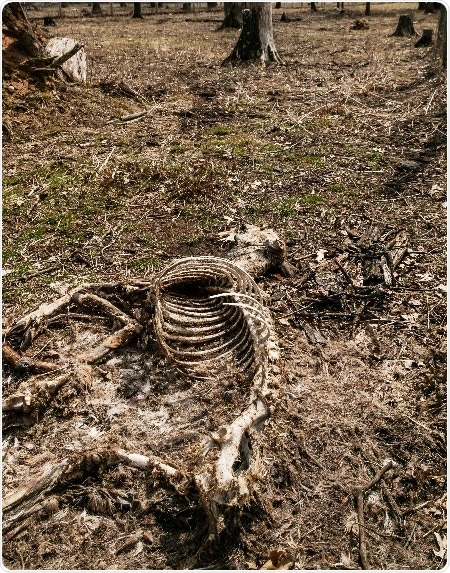
Major soil organic matter compound battles chronic wasting disease
A major compound in soil organic matter degrades chronic wasting disease prions and decreases infectivity in mice, according to a study published November 29 in the open-access journal PLOS Pathogens by Judd Aiken of the University of Alberta, and colleagues.

CWD infectivity is shed from infected deer and released from deer carcasses. CWD then interacts with and can bind to soil components. Image Credit: Judd Aiken, 2018.
Chronic wasting disease is an environmentally transmissible, fatal prion disease affecting free-ranging deer, moose, elk and reindeer. It is endemic in North America, present in South Korea and has recently been confirmed in northern Europe. Environmental prion contamination plays a major role in the increasing incidence of chronic wasting disease, with infectivity being released into the environment by decaying carcasses, or through shedding of biological fluids including urine, feces, and saliva. The transmission of chronic wasting disease involves soils as an environmental reservoir of infectivity. Different soil compounds can differentially bind prions and change their infective properties.
Aiken and colleagues tested the role of a major soil organic matter compound, humic acid, for its ability to bind chronic wasting disease prions and impact infectivity. The researchers examined a wide range of humic acid concentrations, representing the extensive spectrum of humic acid levels present in native soils. The findings suggest that soil organic material degrades chronic wasting disease prions. Incubation of chronic wasting disease prions with high concentrations of humic acids decreased both the chronic wasting disease prion signal and infectivity in mice, whereas lower levels of humic acids did not significantly impact protein stability or infectivity. According to the authors, the study provides new insights into soil-prion interactions, the persistence of prions in soil, and their bioavailability to grazing animals.
Aiken adds:
Source:





















.png)












No hay comentarios:
Publicar un comentario